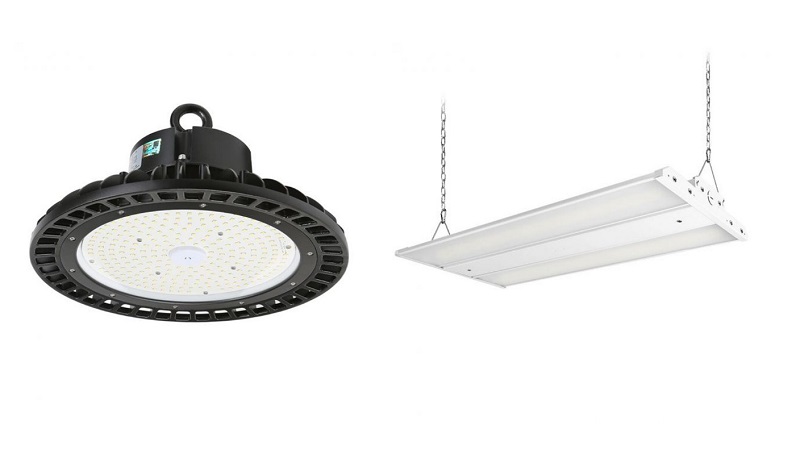You may already have heard about LED lights and LED high bay lights, but you may not be much familiar with LED high bay lights. This article will go through some essential terms, features, benefits, uses, and installation information of LED high bay lights. Usually, we see the use of LED high bay lights in relatively larger indoor spaces where extensive areas need to be illuminated. These lights come in handy where large vertical and horizontal spaces need to be illuminated.
These large spaces include manufacturing plants, departmental stores, auditoriums, factories, and gymnasiums, etc. Such areas need to be illuminated well to keep specific standards. That’s why LED high bay lights are very useful in such situations. However, LED lights are not the first or only lighting option in the market. Before LED lights, fluorescent lights, metal halides, and high-pressure sodium lights were pretty common in the market.
LED High Bay Lights: The Competition
Since the beginning, many types of lighting fixtures are being used for outdoor and indoor applications. Some standard lighting fixtures include metal halides, high-pressure sodium lights, and fluorescent lights, etc. However, the invention of LED lights, especially LED high bay lights, has revolutionized its use in all the earlier applications. Let us go through the comparison of LED high bay lights with some of the significant conventional lighting fixtures.
- Metal halides vs. LED high bay lights
- High-pressure sodium lights vs. LED high bay lights
- Fluorescent lights vs. LED high bay lights
1. Metal halides vs. LED high bay lights
Metal halides are commonly used in warehouses, large retail stores, parking lots, etc. This is due to some of their benefits like excellent color rendering, etc. On the other hand, these metal halides come with some disadvantages such as flickering, high maintenance charges, heat production, and high warm-up time (average warm-up time ranges from 15 to 20 minutes). At the same time, LED high bay lights provide much better efficiency than these lights in terms of energy-saving, lower maintenance, quality of light, and other things. That’s why LED lights are taking the place of metal halides steadily.
2. High-pressure sodium lights vs. LED high bay lights
High-pressure sodium lights or HPS lighting fixtures are commonly used in industrial, business, and sports places where larger areas need to be illuminated. HPS lights are considered to be inexpensive and energy-efficient. On the other hand, the use of HPS lighting fixtures reduces operational costs a lot. However, HPS lights have some drawbacks as well, such as high warm-up time and poor color rendering quality. This is where LED high bay lights perform pretty better.
3. Fluorescent lights vs. LED high bay lights
Fluorescent lighting fixtures are not as standard as the lighting as mentioned earlier in institutions. However, they are being used in industrial applications. The use of fluorescent lights promises lower initial costs and higher efficiency as compared to other conventional lighting methods. However, these lights have a relatively shorter life span and are not a very consumer-friendly product. At the same time, LED high bay lights provide much better efficiency than these lights in terms of energy-saving, lower maintenance, quality of light, and other things. That’s why LED lights are taking the place of metal halides steadily.
150w LED High Bay Lights
LED high bay lights are now used for many applications, including factories, warehouses, airports, sports complexes, stages, transportation garages, etc. Moreover, LED lights are a perfect solution for almost all of your lighting needs. LED high bay lights have proved to be pretty better than all the conventional lighting fixtures. We have already compared LED lights with some other main lighting fixtures in the upper section of this article. Now, let us take a look at the most prominent features of 150w LED high bay lights and the benefits of using these lights over other lighting fixtures. A few of these benefits are enlisted below. You can also buy 150w LED high bay lights online.
- LED high bay lights to require far less maintenance
- LED high bay lights have improved lighting quality
- These lights offer increased energy efficiency
1. Require far less maintenance
Usually, LED high bay lights have a very long life span compared to conventional lighting methods. Typically, LED lights have four to forty times longer running time than the other lighting methods. LED lights provide quality light with far fewer maintenance requirements. Like the filament bulbs, LED lights do not have many moving parts. That’s why these lights run longer than the other options and rarely break down. Moreover, LED high bay lights help in saving costs big time due to their higher life span and lower maintenance needs.
2. LED high bay lights have improved lighting quality
Industrial and high bay LED lights are found to outperform the other conventional lighting options in terms of efficiency and maintenance. Moreover, LED lighting fixtures offer far better color rendering. LED lights to provide better Color Rendering Index (CRI), Foot Candles, and Correlated Color Temperature (CCT). Where Correlated Color Temperature describes the glow of a lighting fixture, LED, lights are much better with respect to these terms as compared to the other lighting fixtures.
3. Offer increased energy efficiency
LED lights have features that allow them to produce and scatter the visible light differently from conventional lighting fixtures. This makes these lights consume less energy as compared to their counterparts. This means LED high bay lights require less energy to provide even better lighting output. That’s why these lights are being considered in almost every field. Industrial LED lights are not omnidirectional like conventional lighting fixtures. This means LED lights do not spread light at 360 degrees. In this way, LED lighting fixtures have eliminated the possible chances of energy wastage. Moreover, LED lights do not produce a lot of heat like the conventional lighting methods.

